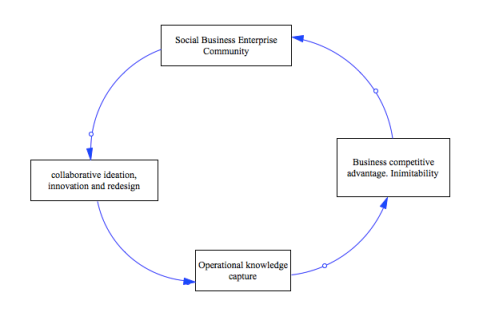Corporations today are in a rapidly changing and increasingly complex environment, they reorganise frequently. In fact, some appear to reorganise continuously. This reorganisation consumes a great deal of time, energy, money and lets not forget morale. The latter, the fear of layoffs is very unsettling and often leads to a marked decrease in productivity and quality of output across the enterprise. In this kind of environment innovation comes to a halt and executives and leadership typically view this as too risky.
When organisations are in this state, the stable state, they are like a coiled spring, their resistance to change tends to be proportional to the effort to change them; the more turbulent the environment, the more stability they seek.
Imagine though, for a moment, that you take the view that your organisation, in these times you should choose to be dynamic. Imagine you could adapt to change without reorganisation, without reorganisation, with less disruptive interventions, then the resistance to change would be significanlty reduced and you would have a more motivated, more productive workforce. This is the multidimensional organisation.
Most organisations are a division of labour. There are typically three; starting with functionally defined units whose outputs are principally consumed or used internally, for example, purchasing, finance, operations, legal, personnel and R&D. As such the organisational chart has a horizontal dimension which shows how labour is divided at each level, that is, how responsibility is allocated. The vertical dimension shows how labour at different levels is coordinated and integrated, that is, how authority is allocated. Typically they are designed from the top down, beginning with the CEO and sometimes a COO. At each successively lower level labour is divided again with one more criteria used at each level. The higher the level of criterion is used, the more importance is attributed to it.
Product or service defined units (its products) the outputs of which are principally consumed by the public such as soft drinks, entertainment and plastic containers for example.
The third and final part of the organisational unit is the market, or user defined units, which are defined by external customers to whom the organisation tries to sell its product. Here the organisations customers are defined by geography or definitions (ultimate consumer, retailers and wholesalers).
By bringing Social Business Software (SBS) into an organisations equation the functional dynamism of the organisation can be fully harnessed. By bringing and entire enterprise across the organisational spectrum together they can, through collaboration move from one needed state to another. For example, should an organisation be experiencing product issues, the enterprise can swarm and assist the product or service defined units into resolving issues and solving problems. Should the enterprise be experiencing consumer related issues, the enterprise could swarm to assist the market, or user defined units into solving problems.
Social Business Software (SBS) breaks down the hierarchies and silos that are prevalent in many organisations today. The overarching methodology is that organisations that deploy SBS successfully become more competitive, more innovative and more successful than their competitors.
Recent statistics reported by McKinsey have the following to say about businesses that have deployed SBS: 79% increase in ideas and innovations for the enterprise leading to a 13% increase in sales revenue leading to a 3-5% increase in overall deal size and bottom line improvement.
By believing that your workforce has a substantial brain capacity and that it is largely untapped leaves many organisations with a great capacity to innovate.

